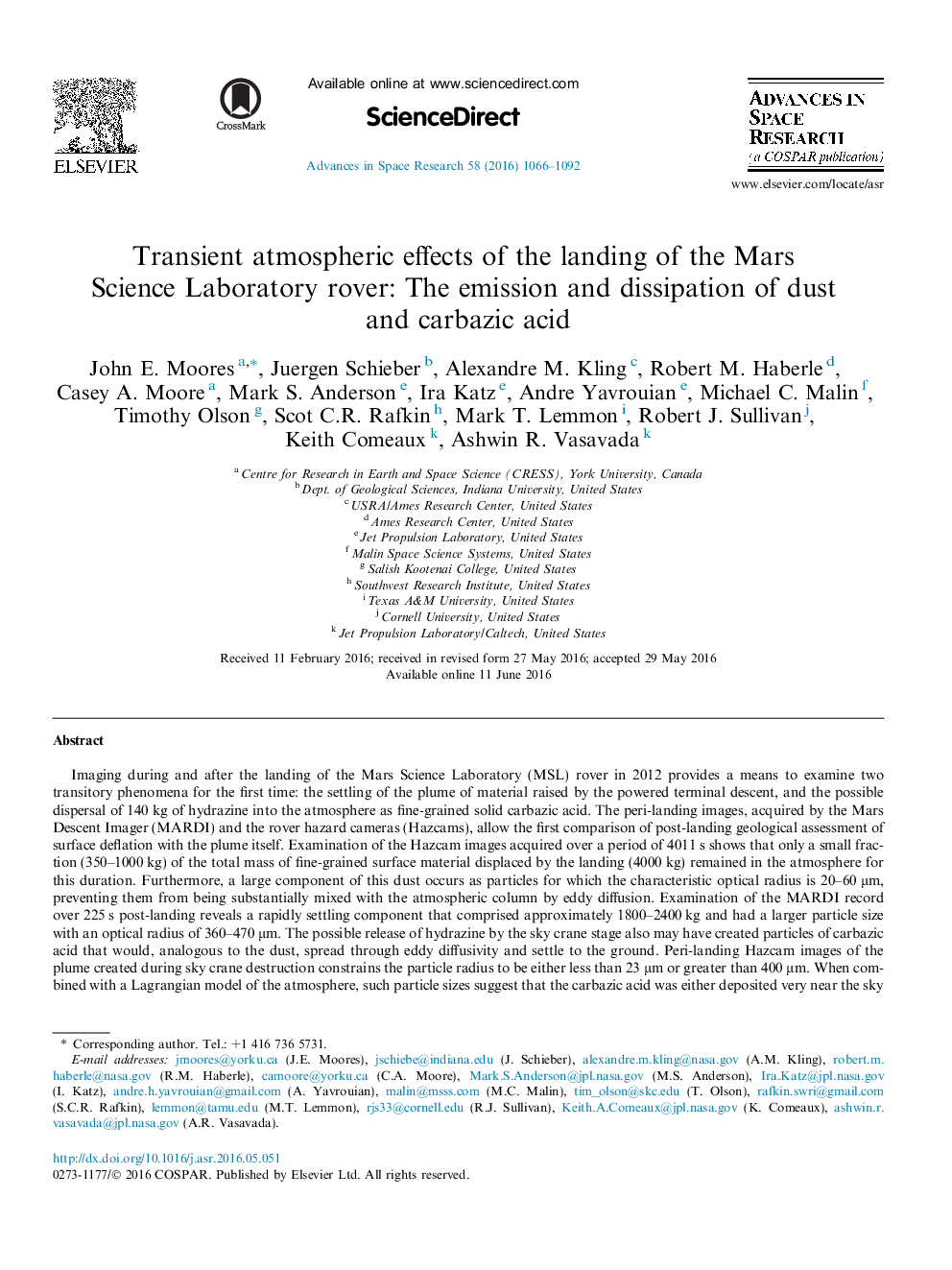| کد مقاله | کد نشریه | سال انتشار | مقاله انگلیسی | نسخه تمام متن |
|---|---|---|---|---|
| 1763220 | 1019989 | 2016 | 27 صفحه PDF | دانلود رایگان |
عنوان انگلیسی مقاله ISI
Transient atmospheric effects of the landing of the Mars Science Laboratory rover: The emission and dissipation of dust and carbazic acid
ترجمه فارسی عنوان
اثرات جوی گذار از فرود مایع آزمایشگاه علوم مریخ: انتشار و انحلال گرد و غبار و اسید کرباسیک
دانلود مقاله + سفارش ترجمه
دانلود مقاله ISI انگلیسی
رایگان برای ایرانیان
موضوعات مرتبط
مهندسی و علوم پایه
علوم زمین و سیارات
علوم فضا و نجوم
چکیده انگلیسی
Imaging during and after the landing of the Mars Science Laboratory (MSL) rover in 2012 provides a means to examine two transitory phenomena for the first time: the settling of the plume of material raised by the powered terminal descent, and the possible dispersal of 140 kg of hydrazine into the atmosphere as fine-grained solid carbazic acid. The peri-landing images, acquired by the Mars Descent Imager (MARDI) and the rover hazard cameras (Hazcams), allow the first comparison of post-landing geological assessment of surface deflation with the plume itself. Examination of the Hazcam images acquired over a period of 4011 s shows that only a small fraction (350-1000 kg) of the total mass of fine-grained surface material displaced by the landing (4000 kg) remained in the atmosphere for this duration. Furthermore, a large component of this dust occurs as particles for which the characteristic optical radius is 20-60 μm, preventing them from being substantially mixed with the atmospheric column by eddy diffusion. Examination of the MARDI record over 225 s post-landing reveals a rapidly settling component that comprised approximately 1800-2400 kg and had a larger particle size with an optical radius of 360-470 μm. The possible release of hydrazine by the sky crane stage also may have created particles of carbazic acid that would, analogous to the dust, spread through eddy diffusivity and settle to the ground. Peri-landing Hazcam images of the plume created during sky crane destruction constrains the particle radius to be either less than 23 μm or greater than 400 μm. When combined with a Lagrangian model of the atmosphere, such particle sizes suggest that the carbazic acid was either deposited very near the sky crane crash site, or was widely dispersed as small particles which would have been quickly photodissociated to volatile ammonia and carbon dioxide. Surfaces visited by the MSL rover, Curiosity, would have received at most <0.2 ppb of carbazic acid and levels of sky crane related organics would have fallen well below the detection threshold of the Sample Analysis at Mars (SAM) instruments within 4-6 sols, well before the rover acquired its first samples over 60 sols into the mission.
ناشر
Database: Elsevier - ScienceDirect (ساینس دایرکت)
Journal: Advances in Space Research - Volume 58, Issue 6, 15 September 2016, Pages 1066-1092
Journal: Advances in Space Research - Volume 58, Issue 6, 15 September 2016, Pages 1066-1092
نویسندگان
John E. Moores, Juergen Schieber, Alexandre M. Kling, Robert M. Haberle, Casey A. Moore, Mark S. Anderson, Ira Katz, Andre Yavrouian, Michael C. Malin, Timothy Olson, Scot C.R. Rafkin, Mark T. Lemmon, Robert J. Sullivan, Keith Comeaux,
